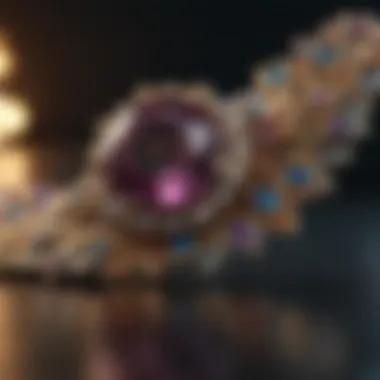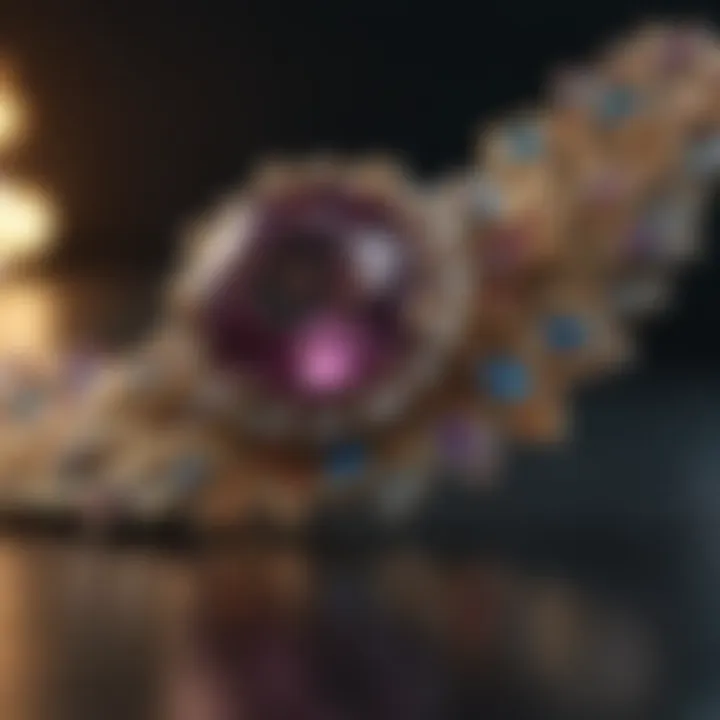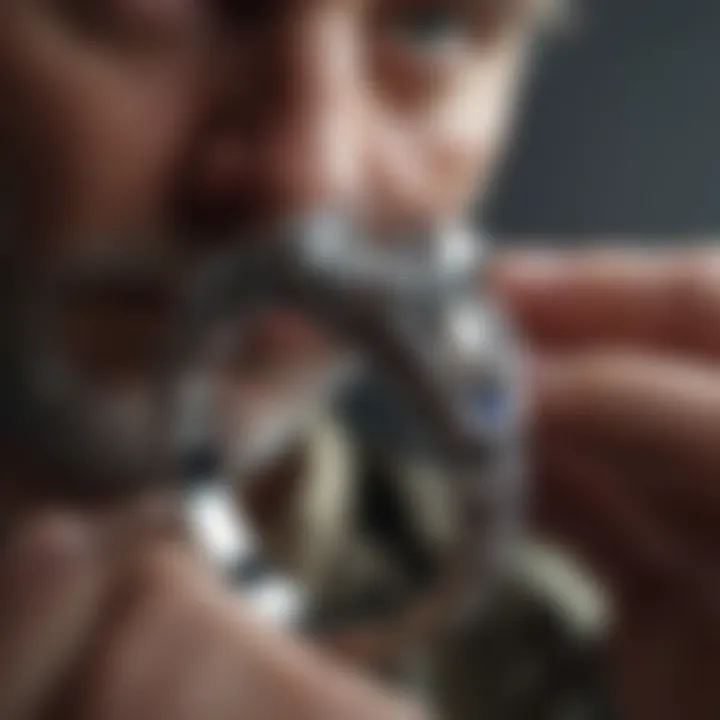Where to Sell Broken Jewelry: A Comprehensive Guide


Intro
Selling broken jewelry can be a daunting task, yet it remains an avenue filled with potential if approached correctly. Many individuals may find themselves in possession of damaged or incomplete jewelry pieces that no longer hold sentimental value. Understanding the intricacies and nuances of this process can significantly enhance the selling experience. In this guide, we will navigate through various platforms, potential buyers, and important factors to consider before taking the plunge into the market for broken jewelry.
Gemstone Overview
A significant aspect of jewelry involves the gemstones used within it, which often dictate both value and desirability.
Definition and Characteristics
Gemstones are naturally occurring minerals that are cut and polished for use in jewelry. They boast unique characteristics, such as luster, color, clarity, and cut. Each of these traits plays an essential role in determining a gemstone's value. A thorough understanding of these characteristics empowers sellers to articulate value accurately.
Classification of Gemstones
Gemstones are commonly divided into two primary categories: precious and semi-precious. Precious gemstones include diamonds, sapphires, rubies, and emeralds. These are often more sought after due to their rarity. Semi-precious gemstones, while valuable, are more accessible and include garnets, amethysts, and turquoise, among others. Knowing the classification can assist individuals in evaluating the worth of their broken jewelry before deciding to sell.
Historical Significance
The rich history of gemstones provides crucial context for their modern-day value and appeal.
Ancient Uses and Cultural Importance
Throughout history, gemstones have served various uses in cultures worldwide. From ancient talismans to adornments in religious ceremonies, these stones held immense importance. Recognizing their past can allow sellers to appreciate their potential worth.
Myths and Legends Surrounding Gemstones
Gemstones are often surrounded by myths that imbue them with magical properties. Some cultures believed they offered protection, luck, or healing. These beliefs can enhance the perceived value of pieces containing certain gemstones, depending on the rarity and the cultural significance they carry.
"Understanding the historical context of gemstones can enrich the selling experience, providing additional narratives for potential buyers."
When considering the sale of broken jewelry, it is vital to approach the market with informed insight. From understanding the gemstones involved to recognizing their historical and cultural significance, every detail can play a role in the successful navigation of the selling process. By grasping these concepts, sellers can make better decisions and create a more compelling case for their items.
Understanding Broken Jewelry
Understanding broken jewelry is crucial for anyone considering selling their pieces. Broken jewelry encompasses not only damaged items but also those that may have missing components, such as lost stones or fragmented chains. Identifying what constitutes broken jewelry helps sellers make informed decisions about their potential sales. The importance of understanding this topic extends beyond simple definitions—it shapes the approach of sellers towards valuation, the choice of sales channels, and how to market these items effectively.
Definition of Broken Jewelry
Broken jewelry refers to any piece that has been compromised in its structure or functionality. This could include necklaces with snapped chains, bracelets with broken clasps, earrings that have lost a stone, or rings that are bent or cracked. Each of these issues can vary in severity, but all reduce the item's usability and market appeal. Therefore, a precise definition is necessary for assessing the jewelry's potential worth and best selling avenues.
Common Types of Broken Jewelry
The types of broken jewelry are varied, reflecting the wide range of jewelry styles and materials. Some common examples include:
- Necklaces: Chains that have broken links or pendants that have come unattached.
- Bracelets: Instances of clasps failing or the bracelet itself snapping.
- Rings: Those that have bent, lost stones, or cracked settings.
- Earrings: One earring out of a pair often becomes the sole item left after a loss.
Understanding these categories helps sellers anticipate challenges in both evaluation and sale.
The Market Value of Broken Jewelry


The market value of broken jewelry often surprises sellers. While damaged, broken pieces can still hold significant worth, particularly if they are made from precious metals like gold, silver, or platinum, or contain valuable gemstones. The following factors contribute to the overall market value:
- Material Composition: Precious metals will typically yield a higher resale value regardless of damage.
- Gemstone Quality: If intact, high-quality stones can significantly enhance value.
- Brand Name: Features associated with well-known designers often carry additional worth, even in damaged condition.
- Demand: Market demand for particular styles or materials can fluctuate, affecting the price.
The dual nature of broken jewelry—both as functional items and investment pieces—makes understanding its market value imperative for an effective selling strategy.
Understanding the nuances of broken jewelry not only enables savvy transactions but also ensures sellers do not overlook valuable opportunities in the market.
Evaluating Your Jewelry
Evaluating your broken jewelry is a crucial first step before deciding to sell. Understanding its condition, worth, and appeal can directly affect your ability to get a fair price. The evaluation process can help prevent potential regret and ensure that you are informed about the options available to you. This section examines key elements involved in evaluating jewelry, including whether it is worth selling, how to obtain a professional appraisal, and the assessment of precious stones and metals.
Is It Worth Selling?
Before embarking on the selling process, it is imperative to consider if your broken jewelry holds any value worth pursuing. Many factors affect whether broken jewelry is substantial enough to sell, including:
- Type of jewelry: Some pieces have intrinsic value regardless of their condition. Items like diamond rings or gold necklaces may still attract interest.
- Emotional attachment: Consider whether the item holds sentimental value. Sometimes, keeping a piece might outweigh the benefits of selling it, no matter its condition.
- Repair costs: Assess the potential costs involved in repairing the jewelry versus its market value. In some cases, investing in repairs may yield a higher selling price later.
It is often helpful to compare your broken jewelry against similar items that are listed for sale online or in stores. This can give you a better idea of market demand and whether it is indeed worth the effort to sell.
Obtaining a Professional Appraisal
A professional appraisal is the best way to ascertain the true value of your broken jewelry. Appraisers have the expertise needed to assess the quality and quantity of precious metals and stones. Here are some reasons why obtaining an appraisal can be beneficial:
- Accurate valuation: An expert can provide you with a precise figure reflecting your jewelry's condition, materials, and market trends.
- Negotiation leverage: A professional valuation can be presented to potential buyers as proof of your jewelry's worth, giving you a stronger position when negotiating a sale price.
- Insurance purposes: If your jewelry has significant value, having it appraised can help in obtaining proper insurance coverage.
To get an appraisal, find accredited appraisers through resources like the American Society of Appraisers or the National Association of Jewelry Appraisers. The cost of an appraisal can vary, but it is generally a wise investment if you are serious about selling.
Assessing Precious Metals and Stones
Understanding the materials in your broken jewelry is vital. Different metals and gemstones have different values, which can greatly influence your selling options. For instance, metals like gold, platinum, or silver usually retain more worth, depending largely on market fluctuations. To effectively assess these elements:
- Identify the metals: Look for markings that indicate the metal type, such as "14K" or "925". This can be helpful in determining purity and potential value.
- Evaluate gemstones: If your broken jewelry contains stones, consider their type and condition. Some gemstones, like diamonds or sapphires, can be very valuable, while others may not carry much worth.
- Research market conditions: Understanding current market trends for both precious metals and stones can help gauge when to sell. Prices fluctuate regularly due to economic conditions, so timing may impact your overall profits.
A clear evaluation, professional advice, and a basic understanding of your jewelry's components can lead you to a well-informed sale. This process prepares you for the next steps in selling your broken pieces effectively.
Where to Sell Broken Jewelry
Selling broken jewelry can be a practical decision for many reasons. Often, pieces that no longer serve their original purpose still possess intrinsic value based on materials and craftsmanship. Understanding where to sell these items is crucial to maximizing returns. Several platforms and buyers are available, each offering distinct advantages and considerations. Timing and local market demand also influence the best approach for selling broken jewelry.
Local Jewelers
Engaging with local jewelers becomes a straightforward option for those looking to sell broken jewelry. Local shops often have established networks and relationships within their communities, which can expedite the selling process. Jewelers may vary in their willingness to buy broken items, which is why it’s essential to visit several shops to gauge interest and get various offers.
Additionally, selling to a local jeweler can provide benefits such as immediate payment and the possibility of a more personalized transaction. Keeping in mind that jewelers may assess repair costs against purchasing prices, this can affect the offer presented.
Pawn Shops
Pawn shops offer another avenue for selling broken jewelry. They operate on a model that allows for quick cash in exchange for items, including damaged jewelry. Sellers can walk into a pawn shop, show their pieces, and receive an offer on the spot. The process is typically fast, making it convenient for those in urgent need of cash. However, sellers should be cautious.
The offers from pawn shops may be lower compared to other options due to their resale model, which expects to profit from resale value. Accordingly, sellers should have clear expectations and consider what they are willing to accept. Pawn shops often operate under strict regulations, so it’s advisable to choose reputable ones.


Online Marketplaces
The rise of online marketplaces has transformed the way broken jewelry can be sold. Platforms such as eBay, Etsy, or even specialized sites like Worthy allow sellers to reach a broader audience. This can lead to competitive pricing and potentially higher sales than traditional methods.
When selling online, sellers need to invest time in creating accurate and appealing listings. Clear descriptions and high-quality images are essential to attract potential buyers. It's important to research platforms that cater specifically to jewelry, as they can provide a more targeted audience and potentially higher value.
One significant benefit of online selling is the flexibility it offers. Sellers can set their own prices and choose when to engage with buyers, which can make for a less pressured selling environment.
Specialized Buyback Programs
Specialized buyback programs have emerged as a viable option for selling broken jewelry. These programs are often run by dedicated companies that focus on buying damaged or unwanted pieces for recycling or resale purposes. They usually provide a hassle-free experience, offering pre-paid shipping labels and guaranteed offers once the items are received.
Sellers benefit from the transparency these programs offer, as they often detail how offers are calculated based on weight, material quality, and current market trends. However, sellers should compare offers from various companies, as they can vary widely.
In summary, the choice of where to sell broken jewelry depends largely on individual circumstances, such as urgency, item condition, and value expectations. Whether through local jewelers, pawn shops, online marketplaces, or specialized buyback programs, a range of selling options exists to cater to different seller needs.
Selling Strategies
In the world of broken jewelry sales, selling strategies play a crucial role in determining how quickly and profitably one can complete the transaction. An effective approach can not only enhance the appeal of your items but also ensure that buyers recognize the value embedded within them. Strategies can influence the overall perception of broken jewelry, which often carries a stigma that might undermine its value.
When selling broken jewelry, several specific elements warrant consideration to maximize returns. These include creating an accurate description of the piece, taking quality photographs that highlight details, and setting a realistic price based on current market trends.
Creating an Accurate Description
An accurate description is indispensable. It should capture essential details including the type of metal, gemstones involved, and the item’s condition. Utilizing precise language allows potential buyers to assess the jewelry effectively. Describe any unique features, such as distinctive cuts or styles that may enhance its appeal. Briefly mention flaws, as transparency fosters trust and encourages serious inquiries. Consider utilizing common terms used within the jewelry industry, as this will resonate well with knowledgeable buyers. For example:
- Material Composition: Clearly state the metals involved, such as gold, silver, or platinum.
- Gemstone Details: Include the type of gemstones, whether they are diamonds, rubies, or other stones, and their condition.
- Design Elements: Acknowledge any intricate designs or artistic merits.
Taking Quality Photographs
The significance of quality photographs cannot be overstated. Clear and detailed images can substantially impact a buyer's interest. Aim to capture each piece from multiple angles and in good lighting. The background should be simple to avoid distractions. Here are practical tips:
- Lighting: Use natural light, or a lightbox, to illuminate the jewelry, emphasizing its features.
- Close-ups: Capture close-ups of details, such as clasps or marks that indicate authenticity.
- Contextual Images: If possible, include context shots with the jewelry worn or next to commonly known objects, which can provide scale.
Setting a Realistic Price
Lastly, setting a realistic price is paramount. Factors influencing the value of broken jewelry include the current market rates for precious metals and the condition of the piece. Research similar items to gauge appropriate pricing. Consider these aspects:
- Market Trends: Familiarize yourself with the fluctuating prices of gold and silver.
- Condition Assessment: Adjust your pricing based on how much restoration is needed.
- Comparison: Look at similar listings on platforms, including eBay or Facebook Marketplace, to find a competitive price point.
"Understanding the intricacies of selling strategies is vital; it transforms how buyers perceive your broken jewelry, ultimately enhancing your chances of a fruitful sale."
By employing these selling strategies thoughtfully, you increase the likelihood of attracting interested buyers. Tailoring your descriptions, utilizing quality photography, and establishing a fair price can evolve your selling experience from merely transactional to an opportunity for engagement and satisfaction.
Legal Considerations
When dealing with broken jewelry, understanding legal considerations is critical. Selling jewelry, even if it is broken, involves compliance with various regulations. Ignoring these aspects can lead to complications, from financial penalties to issues regarding the legality of ownership. It's worth understanding the local laws before proceeding with the sale.
Understanding Local Regulations
Local regulations may differ significantly from one place to another. Some regions have strict laws regarding the resale of used or broken jewelry. It's essential to familiarize yourself with these laws to ensure compliance. In some areas, jewelers and pawn shops are required to maintain detailed records of sales. This can include the seller's identification and descriptions of the jewelry.


Before selling, check if you need any permits or licenses. Some municipalities may have laws aimed at preventing stolen goods from being sold without proper verification. Understanding these regulations can protect you from potential legal consequences, such as fines or criminal charges. You can often find this information through your local government’s website or by contacting a local authority directly.
Tax Implications of Selling Jewelry
Selling broken jewelry may also have tax implications. When you sell any asset, earnings can be subject to capital gains tax. Even if the jewelry was originally bought at a high price, selling it broken could affect its valuation and, consequently, any tax obligations. For clarity, it is advisable to keep detailed records of your purchase price and sale price.
Consult with a tax professional to understand how capital gains tax applies to your specific situation. You may also find varying rules depending on your location. Some areas allow exemptions for small sales, while others may require all transactions to be reported.
Engaging with a qualified accountant can help unravel these complexities. They can guide you on the best practices for documentation and compliance, ensuring that your selling process is both legal and financially sound.
In summary, understanding and complying with legal considerations regarding local regulations and tax implications is necessary for anyone looking to sell broken jewelry. By equipping yourself with this knowledge, you can navigate the selling process with confidence and avoid any potential pitfalls.
Post-Sale Actions
The post-sale actions taken after selling broken jewelry are critical in formalizing the transaction and ensuring a smooth experience for both seller and buyer. These actions can help solidify the sale's legitimacy, provide necessary financial records, and advise on how to handle any remaining jewelry that was not sold. Understanding these steps can ease the transition into spending or reinvesting the proceeds effectively.
Documenting the Sale
Proper documentation of the sale is essential. A transaction record should include details such as:
- Date of sale: Always keep a clear date when the transaction occurred.
- Buyer’s information: This could be a name, email address, or business information, depending on how the transaction is made.
- Item description: Document what was sold, including any specific attributes such as materials or gemstones.
- Sale price: Record the final sale price to have a reference for future transactions.
- Payment method: Keep track of whether the payment was made via cash, bank transfer, or another method.
This documentation can be helpful for potential disputes and is also useful when filing taxes. A simple sales receipt can usually be created, or you might prefer to keep a digital record.
Handling Payment
Handling payments correctly prevents issues down the line. Make sure to verify the payment is complete before finalizing the sale. Here are some important considerations:
- Ensure funds clearance: If receiving payment through a check or electronic transfer, confirm that the payment has cleared. This is crucial as bounced checks or fraudulent transfers can lead to losses for the seller.
- Receipt provision: Providing a receipt can offer peace of mind for the buyer and help formalize the transaction.
- Record keeping: Maintain records of the payment for tax purposes or any potential agreements. This helps demonstrate gains when completing financial documents.
Using secure payment methods protects both parties. Consider using established platforms like PayPal, Venmo, or even bank transfers, especially for higher-valued transactions.
What to Do with Remaining Pieces
After selling some jewelry, some sellers may still possess pieces that did not find buyers. Handling these left-over items wisely can maximize potential returns. Options for remaining jewelry include:
- Consider Upcycling: If there are broken pieces or scraps, think about taking them to a jeweler for remaking into something new. This can add value and also allow for personal enjoyment.
- Storage: If you prefer to keep the remaining pieces, store them properly. Use soft cloths or jewelry boxes to prevent tarnishing or damage.
- Future Sales: You may reconsider selling them later. Keeping abreast of market trends can inform better future selling decisions.
In summary, post-sale actions are not just procedural; they provide clarity and security in transactions. Being deliberate about documentation, payment processing, and the fate of remaining items ensures a seamless experience with broken jewelry sales. By considering these elements, sellers can enhance their understanding of the industry and make more informed choices.
Culmination
The conclusion of this article serves as a critical component for understanding the entire process of selling broken jewelry. It is not just a summary; instead, it highlights the essential points covered throughout the guide. This section synthesizes key insights and reevaluates the journey one undergoes when faced with the choice to sell broken pieces.
The importance of this conclusion lies in its ability to distill complex information into actionable advice. Readers can grasp the various options available to them, from local jewelers to specialized buyback programs. They gain a clearer perspective on evaluating the worth of their items and understanding the legal implications involved in the sales process. In an era where environmental sustainability is crucial, selling old or broken jewelry fosters responsible consumption and recycling.
Key Takeaways
- Know Your Options: Several avenues exist to sell broken jewelry, including local jewelers, pawn shops, online marketplaces, and buyback programs.
- Evaluate Before Selling: An appraisal is essential. Understanding the value of precious metals and stones in your jewelry will aid in setting realistic expectations.
- Document Everything: Keep records of the sale for future reference and possible tax implications.
- Consider Local Regulations: Each region may have specific laws governing jewelry sales, affecting how you proceed.
Final Thoughts on Selling Broken Jewelry
Selling broken jewelry presents a unique opportunity to reclaim value from items that may otherwise go unnoticed. The act of selling can also free up space, relieve emotional attachments, and turn forgotten treasures into cash. However, this process requires careful consideration and awareness of potential pitfalls.
It is vital to approach the selling process with diligence. Proper research on selling venues and an understanding of market dynamics can make a significant difference. Don’t hesitate to seek professional advice when appraisal is necessary.
As we navigate the sometimes intricate pathways of selling broken jewelry, remember that informed decisions lead to empowering outcomes. After all, each piece carries a history worth recognizing—whether it finds a new home or contributes to sustainable practices.







